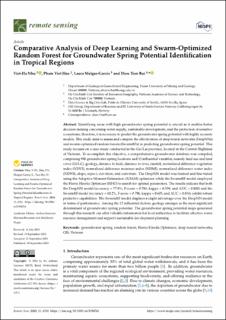| dc.identifier.citation | Nhu, V.-H., Hoa, P. V., Melgar-García, L., & Tien Bui, D. (2023). Comparative Analysis of Deep Learning and Swarm-Optimized Random Forest for Groundwater Spring Potential Identification in Tropical Regions. Remote Sensing, 15(19), Artikkel 4761. | en_US |
| dc.description.abstract | Identifying areas with high groundwater spring potential is crucial as it enables better decision-making concerning water supply, sustainable development, and the protection of sensitive ecosystems; therefore, it is necessary to predict the groundwater spring potential with highly accurate models. This study aims to assess and compare the effectiveness of deep neural networks (DeepNNs) and swarm-optimized random forests (SwarmRFs) in predicting groundwater spring potential. This study focuses on a case study conducted in the Gia Lai province, located in the Central Highland of Vietnam. To accomplish this objective, a comprehensive groundwater database was compiled, comprising 938 groundwater spring locations and 12 influential variables, namely land use and land cover (LULC), geology, distance to fault, distance to river, rainfall, normalized difference vegetation index (NDVI), normalized difference moisture index (NDMI), normalized difference water index (NDWI), slope, aspect, elevation, and curvature. The DeepNN model was trained and fine-tuned using the Adaptive Moment Estimation (ADAM) optimizer, while the SwarmRF model employed the Harris Hawks Optimizer (HHO) to search for optimal parameters. The results indicate that both the DeepNN model (accuracy = 77.9%, F-score = 0.783, kappa = 0.559, and AUC = 0.820) and the SwarmRF model (accuracy = 80.2%, F-score = 0.798, kappa = 0.605, and AUC = 0.854) exhibit robust predictive capabilities. The SwarmRF model displays a slight advantage over the DeepNN model in terms of performance. Among the 12 influential factors, geology emerges as the most significant determinant of groundwater spring potential. The groundwater spring potential maps generated through this research can offer valuable information for local authorities to facilitate effective water resource management and support sustainable development planning. | en_US |

